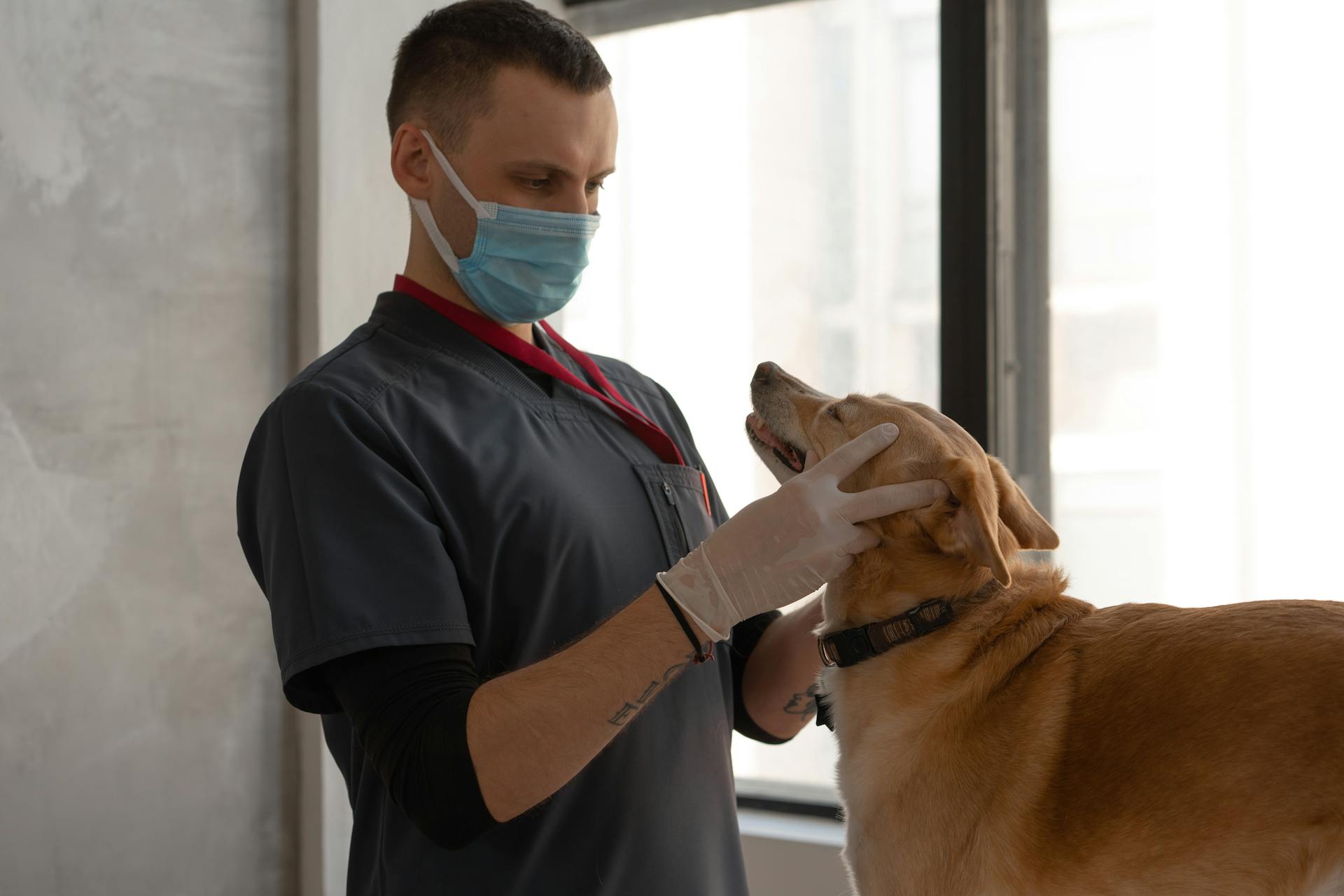
Canine blood cancer is a devastating diagnosis for any dog owner.
According to recent studies, the most common types of blood cancer in dogs are lymphoma and leukemia.
Lymphoma can affect any age group, but it's most common in dogs between 5-14 years old.
Dogs with a history of allergies or autoimmune disorders are at a higher risk of developing lymphoma.
Lymphoma can be treated with chemotherapy, but the prognosis varies depending on the stage and type of cancer.
Additional reading: Canine Ocular Lymphoma
Diagnosis
If you notice a suspicious skin mass on your dog, larger than a pea or lingering for over a month, get it checked out by a vet.
A vet will perform a fine needle aspiration to procure a sample, which is a crucial step in diagnosing hemangiosarcoma.
Bloodwork is also a key diagnostic tool, assessing liver and kidney function, as well as electrolytes and certain gastrointestinal enzymes.
Urinalysis, a non-invasive urine test, helps evaluate renal function and screen for possible urinary tract inflammation and infection.
Diagnostic imaging, such as chest radiography (x-rays) and abdominal radiography +/- sonography, can screen for evidence of heart and lung changes, including metastasis.
A definitive diagnosis of hemangiosarcoma is made by removal and biopsy of the tumor.
In some cases, an abdominal ultrasound, X-rays, and a CT scan may be recommended to diagnose internal tumors.
A thorough physical exam and patient history are essential in diagnosing lymphoma, which may involve needle aspiration to identify cells within enlarged lymph nodes.
Here's a summary of common diagnostic tests for canine blood cancer:
Treatment Options
Surgery is a common treatment for canine blood cancer, but it's often not enough on its own. The median survival time for dogs with splenic hemangiosarcoma treated only with surgery is 19-86 days.
Chemotherapy is a crucial part of treatment, especially for dogs with internal hemangiosarcoma. Doxorubicin is a common chemotherapeutic agent used to treat hemangiosarcoma, and it's associated with longer survival times.
If this caught your attention, see: Canine Cancer Treatment
For dogs with skin hemangiosarcoma, surgical removal of the tumor can be curative, with a median survival time of 780 days. However, if the tumor can't be completely removed, chemotherapy may be recommended.
In some cases, chemotherapy may be administered after surgery to slow down or delay the spread of the tumor. This is especially important for dogs with internal hemangiosarcoma, which has a poor prognosis.
Here are some common treatment options for canine blood cancer:
Keep in mind that every dog is different, and the best treatment plan will depend on the individual dog's needs and circumstances. It's always best to consult with a board-certified veterinary oncologist to determine the most effective treatment plan.
Readers also liked: Canine Liver Cancer Treatment
Signs and Symptoms
A tumor on or under the skin will often look like a dark red or purple bump that may bruise or bleed.
Early signs of canine blood cancer can be as subtle as lethargy and pale gums.
As the tumor grows, blood vessels supporting it begin to leak, resulting in blood loss into the abdomen.
Weight loss, decreased appetite, increased panting, weakness, cough, or a bulging belly can be symptoms of a hemangiosarcoma.
A sudden weakness and a swollen or pendulous abdomen or pale gums can be a sign of the spleen rupturing and hemorrhaging.
For your interest: Canine Abdominal Anatomy
Studies and Research
Canine blood cancer is a leading cause of death in dogs, with lymphoma being the most common type, affecting up to 30% of all canine cancer cases.
Research has shown that genetics play a significant role in the development of blood cancer in dogs, with certain breeds being more prone to the disease.
The median age of diagnosis for canine lymphoma is around 10 years, with a range of 6 to 17 years.
Studies have also identified a link between environmental factors, such as exposure to pesticides and heavy metals, and the development of blood cancer in dogs.
Here's an interesting read: Canine Epitheliotropic Lymphoma
Canine blood cancer is often diagnosed through a combination of physical examination, imaging tests, and biopsy results.
The prognosis for dogs with blood cancer varies depending on the type and stage of the disease, with some cases being more treatable than others.
Research has led to the development of new treatment options for canine blood cancer, including chemotherapy and immunotherapy.
Specific Types of Cancer
Canine lymphoma is a common type of cancer that affects middle-aged to older dogs. It arises from lymphoid tissue in various parts of the body.
The exact cause of canine lymphoma is unknown, but environmental and genetic factors have been thought to play a role. Certain breeds, such as Boxers, Labrador Retrievers, Basset Hounds, Saint Bernards, and Scottish Terriers, are more predisposed to developing this type of cancer.
The most common type of canine lymphoma is multicentric, which accounts for about 80 percent of cases. This type of cancer originates in multiple places and is often characterized by the enlargement of lymph nodes, which can swell up to ten times larger than normal.
Here are some common symptoms of canine lymphoma:
- Enlargement of the lymph nodes, spleen, and/or liver
- Anorexia
- Weight loss
- Fluid in the abdomen
- Difficulty breathing
- Increased thirst
- Vomiting and/or diarrhea
- Fever
- Weakness
- Lethargy
- Skin lesions
What Is Canine Blood Cancer
Canine blood cancer, also known as lymphoma, is a type of cancer that affects a dog's immune system.
It's the most common type of cancer in dogs, with an estimated 10,000 to 20,000 new cases diagnosed each year in the United States alone.
Lymphoma can occur in any age group, but it's most commonly diagnosed in dogs between the ages of 5 and 14.
The disease typically begins in the lymph nodes, spleen, or bone marrow, and can then spread to other parts of the body, including the liver, kidneys, and lungs.
Symptoms of lymphoma can vary depending on the location and severity of the disease, but common signs include swollen lymph nodes, weight loss, and lethargy.
Some breeds, such as Basset Hounds and Bulldogs, are more prone to developing lymphoma due to their genetic predisposition.
Treatment options for canine blood cancer typically involve chemotherapy, radiation therapy, or surgery, and the goal is usually to manage the disease and improve the dog's quality of life.
A fresh viewpoint: Canine Lupus
Breeds and Health Conditions
Some breeds are more prone to certain types of cancer than others.
Golden Retrievers are among the most commonly affected breeds by hemangiosarcoma cancer.
German Shepherds are also at a higher risk of developing this cancer.
Portuguese Water Dogs, Boxers, and Skye Terriers are other breeds that are often affected by hemangiosarcoma.
Staying aware of your dog's energy levels and skin is crucial for owners of these breeds.
Vigilance is the best support for your dog friend, especially if you own one of these breeds.
Leukemia
Leukemia is a type of cancer that affects dogs, and it's essential to know the signs and treatment options.
Acute lymphoblastic leukemia is a severe form of leukemia that often goes undetected until it has progressed in severity, and its clinical signs may include loss of appetite, lethargy, and weight loss.
Chronic lymphocytic leukemia is much rarer and can be difficult to detect, with some dogs experiencing increased thirst and urination, fevers, or enlarged lymph nodes.
A thorough physical exam, bloodwork, and a bone marrow biopsy are necessary to diagnose leukemia in dogs.
The prognosis for pets diagnosed with acute leukemia varies widely, but it's considered grave, and regular veterinary checkups can help detect this disease early.
Acute leukemia can be treated with aggressive chemotherapy, while chronic leukemia may require continued monitoring.
Lymphoma
Lymphoma is a type of cancer that affects middle-aged to older dogs. It arises from lymphoid tissue within the bone marrow, thymus, lymph nodes, spleen, and gastrointestinal tract.
The exact cause of lymphoma is unknown, but environmental and genetic factors are thought to play a role. Certain breeds, such as Boxers, Labrador Retrievers, Basset Hounds, Saint Bernards, and Scottish Terriers, are more predisposed to developing this type of cancer.
The most common type of lymphoma in dogs is multicentric lymphoma, which accounts for about 80 percent of canine cases. This type of lymphoma originates in multiple places and is often indicated by the enlargement of lymph nodes.
A dog's lymph nodes may swell up to ten times larger than normal. Other less common forms of lymphoma include alimentary (digestive tract) lymphoma, mediastinal lymphoma, and extranodal lymphoma.
Some common symptoms of lymphoma in dogs include:
- Enlargement of the lymph nodes, spleen, and/or liver
- Anorexia
- Weight loss
- Fluid in the abdomen
- Difficulty breathing
- Increased thirst
- Vomiting and/or diarrhea
- Fever
- Weakness
- Lethargy
- Skin lesions
Dogs and Cancer
Hemangiosarcoma in dogs is a malignant tumor that arises from the walls of blood vessels, and it's considered one of the meanest cancers out there.
Middle-aged to older dogs are more susceptible to developing hemangiosarcoma, which is a strong genetic component.
The breeds most likely to develop this type of cancer are Golden Retrievers, German Shepherds, Boxers, Labrador Retrievers, and English Setters.
The tumor can develop on any blood vessels, but it most frequently occurs as a mass in the spleen, liver, or right atrium of the heart.
The initial growth of the tumor is slow and painless, making it difficult to detect until it has become more severe or metastasized to other areas of the body.
Clinical signs of hemangiosarcoma can be nonspecific, such as lethargy or weakness.
Frequently Asked Questions
How long can a dog live with blood cancer?
Survival time for dogs with blood cancer typically ranges from 1 to 3 years after treatment begins, depending on the type and severity of the condition
How long will a dog live with a hemangiosarcoma?
Unfortunately, the prognosis for dogs with hemangiosarcoma is generally poor, with a high mortality rate within one to two years post-diagnosis. Treatment options, including surgery and chemotherapy, can extend a dog's life for a few months, but the outcome is often severe
How long can a dog live with lymphoma with treatment?
With treatment, a dog's lifespan with lymphoma can range from approximately 1 year, but individual cases can vary significantly. Some dogs may live longer than a year, making every case unique
Sources
- https://vecc24.com/hemangiosarcoma-dogs-aggressive-blood-vessel-cancer/
- https://www.thewildest.com/dog-health/hemangiosarcoma-in-dogs
- https://www.pethealthnetwork.com/dog-health/dog-diseases-conditions-a-z/hemangiosarcoma-dogs
- https://blog.healthypawspetinsurance.com/hemangiosarcoma-leukemia-and-lymphoma-in-dogs
- https://www.ed.ac.uk/vet/news-events/2023-news/blood-test-monitors-progress-of-cancer-in-dogs
Featured Images: pexels.com


